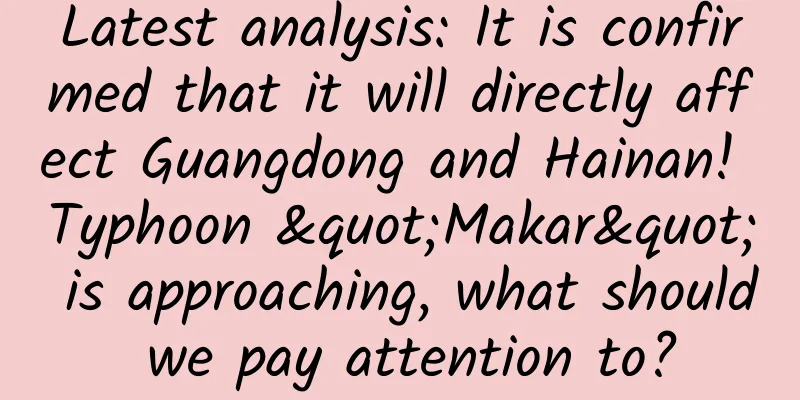Latest analysis: It is confirmed that it will directly affect Guangdong and Hainan! Typhoon "Makar" is approaching, what should we pay attention to?

|
Typhoon Makar was formed in the northwest Pacific Ocean east of the Philippines at 23:00 on September 1. It entered the South China Sea on the morning of the 3rd and headed towards the coast of southern my country. The latest analysis: It is confirmed that it will directly affect Guangdong and Hainan! On the evening of September 2, the Guangdong Provincial Flood Control Headquarters held a typhoon prevention work meeting to organize the assessment of the typhoon defense situation and study and deploy various typhoon prevention measures. The meeting pointed out that from the analysis, the uncertainty of the future development of Typhoon "Makar" is relatively large, but it is certain that the typhoon will directly affect Guangdong. It is expected that "Makar" can reach the strongest typhoon level or super typhoon level, and the typhoon prevention situation is very severe. According to Guangdong Radio and Television Station, Typhoon "Makar" may cause Guangdong to "stop three things and rest one thing", namely, stop work, stop production, stop classes, and stop business. According to the Central Meteorological Observatory on the morning of September 3, the path of Typhoon "Makar" continued to adjust southward, and will approach the sea east of Hainan Island in the future. Its intensity will gradually increase, and it will make landfall on the coast from eastern Hainan Island to western Guangdong in the afternoon to night of the 6th. The Central Meteorological Observatory issued a typhoon blue warning at 10:00 on September 3: The center of this year's 11th typhoon "Makar" (tropical storm level) was located at 8 o'clock this morning (3rd) off the northwest coast of Luzon Island in the Philippines, that is, 18.2 degrees north latitude and 119.7 degrees east longitude. The maximum wind speed near the center was level 9 (23 meters/second), the lowest central pressure was 990 hPa, and the radius of the level 7 wind circle was 150-250 kilometers. Image source: China Central Meteorological Observatory official website It is expected that "Makar" will move northwestward at a speed of about 10 kilometers per hour, and will soon enter the eastern waters of the South China Sea, and then approach the sea east of Hainan Island. Its intensity will gradually increase, and it will make landfall on the coast from the eastern part of Hainan Island to the western part of Guangdong during the day on the 6th. The maximum wind speed near the center is expected to be 14-15 (42-50 meters/second, strong typhoon level) when it lands. It will then pass through Hainan Island and move into the Beibu Gulf in the early morning of the 7th. What is the difference between a typhoon and a hurricane? Typhoons and hurricanes are actually tropical cyclones. According to the definition of the World Meteorological Organization, tropical cyclones with central wind force of more than level 12 and wind speed of 32.7 meters per second can be called typhoons or hurricanes. The difference is that tropical cyclones occurring in the northwest Pacific Ocean and the South China Sea are the typhoons we are familiar with, while those occurring in the northeast Pacific Ocean and the Atlantic Ocean are called hurricanes. In addition, typhoons and hurricanes have a little brother, that is, tropical cyclones occurring in the Indian Ocean with central wind force of more than level 12 - "cyclones". Typhoons, hurricanes and cyclones are essentially the same, but they have different names due to their different birthplaces. In China, typhoons can be classified from weak to strong into tropical depression, tropical storm, severe tropical storm, typhoon, strong typhoon, and super typhoon according to the different wind speeds in the center of the typhoon. Generally, those above level 16 are called super typhoons . According to the standards of the National Hurricane Center, hurricanes are divided into five levels, namely Category 1, Category 2, Category 3, Category 4 and Category 5 hurricanes, with corresponding maximum wind speeds of 74-95 mph, 96-110 mph, 111-130 mph, 131-155 mph and above 156 mph. Why do autumn typhoons “favor” Guangdong and Hainan? Autumn typhoons usually refer to typhoons generated from September to November, so even though the temperature is still scorching hot in many parts of the south, they will still be affected by autumn typhoons. When the summer turns to the autumn, the sun's direct point moves from north to south, causing the sea temperature to be warmer. High sea temperature means more heat is accumulated, which provides more energy to typhoons, making it more likely for super typhoons to occur. Compared with summer typhoons, autumn typhoons land further south, mainly concentrated in the area south of Zhejiang. The provinces most likely to land are Guangdong and Hainan. This is because after entering autumn, the subtropical high pressure that affects the path of tropical cyclones begins to retreat eastward and southward, and its position gradually moves southward. The movement paths of autumn typhoons are mostly tortuous and the intensity is variable. During this period, the subtropical high pressure, the equatorial convergence zone and the northern cold air are in a state of game, so the typhoon is affected by many factors, and its movement path and intensity are also prone to change. Moreover, after entering the South China Sea, the complex terrain will also make the path and intensity changes of autumn typhoons more complex. So everyone should pay close attention to the latest forecast and warning information. Once a typhoon hits How to take precautions and respond? The public is requested to pay attention to the forecast and warning information released by the meteorological department in the future, pay attention to the development and impact of "Capricorn", and take precautions! Comprehensive sources: Ministry of Emergency Management, Central Meteorological Observatory, Guangdong Emergency Management, etc. |
<<: Three pieces of silk fabrics recreate the shock of the Silk Road!
Recommend
New research: Tiny electric sparks from waves hitting the shore may be the spark of the origin of life on Earth
In science fiction, the birth of life is sometime...
Activity Operation: How to design activity prizes that stimulate user desire?
All methods of gaining traffic are designed as ba...
The first stage of product growth: user acquisition
The user growth framework originates from the con...
Does high blood pressure mean hypertension? Experts debunk rumors: Don’t be fooled by the illusion of high blood pressure!
I saw such a patient in the outpatient clinic on ...
Local service promotion sideline, precise traffic monetization project
In the past few days, I have talked a lot about l...
It can cause poisoning and diarrhea at the mildest, and cancer and death at the worst! Don't eat like this anymore
This article was reviewed by: Li Xue, Peking Unio...
Bilibili v5.52.0 modified version unlocks the theme and breaks the cache copyright restriction_Free software download center, ai software
Software Information Name: Bilibili Package name:...
Why do urine tests require “midstream urine”? Will the front and back urine affect the results?
Review expert: Cao Qingwei, deputy chief physicia...
Poplar and willow catkins are coming! Take this guide to prevent catkins for people with allergies
Willow catkins are coming! Keep this guide on how...
Sky-high prices for sports event copyrights: Is the pay-per-view model the ultimate weapon?
Tencent paid 500 million US dollars for the exclu...
Less than a year after its launch, how is NetEase Wugu Reading operating?
Who is NetEase Wugu Reading ? An app for reading ...
Analysis of Zhihu’s operation and promotion strategies!
On August 12, 2019, Zhihu completed its F round o...
The most complete! New product launch event process planning plan!
The most important thing about an event is to hav...
Analysis of Xiaohongshu's competitive products
From sharing overseas shopping to establishing it...
Gaming on smartwatches: Break through or stop
Editor's note: I always think that making gam...









